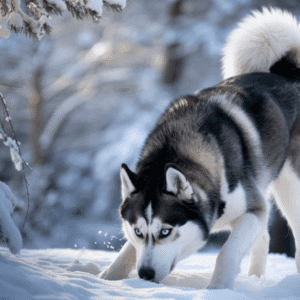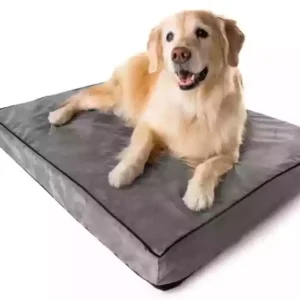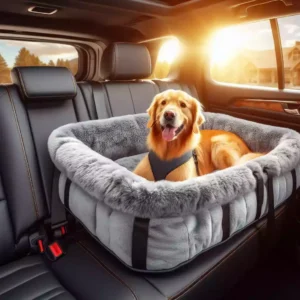
Bringing a puppy home is exciting, but teaching them to use the bathroom is key. Every mess or late-night bathroom trip shows why starting early is crucial. This guide will help you turn stress into a plan, using science and simple steps to create a routine that suits you both.
A crate that’s just the right size helps your puppy keep their sleeping area clean3. If it’s too big, they might not use it; too small, and they’ll feel trapped. Look for a crate where your puppy can stand and turn but not much more3. Feed puppies 2 hours before bedtime to help them sleep through the night.
Key Takeaways
- Use a crate sized to prevent soiling—big enough for comfort but not accidents23.
- Stick to 4-5 hour intervals overnight for puppies 8-12 weeks old1.
- Pair crates with treats to create a safe space3.
- Professional programs like Off Leash K9 Training of Hampton Roads offer tailored help3.
- Avoid stimulating play during nighttime trips to avoid confusion1.
Understanding Puppy Potty Training
Housebreaking tips work best when you understand a puppy’s instincts and biology. Their small bladders mean they need to go often.
The Science Behind Housetraining
Puppies naturally avoid soiling where they sleep, a survival instinct you can use for training. At 2 months, they can hold it for up to 3 hours. This helps you plan their bathroom breaks.
- Take them outside every 1-2 hours during play or meals.
- Cratese time should not exceed their age in months plus one hour.
- Pair with high-value treats during successes to reinforce positive behavior.

Benefits of Early Potty Training
Starting training early cuts down accidents by 60% and prevents future problems. Early routines teach impulse control, reducing anxiety-driven chewing or scratching. The main benefits are:
- Less cleanup with consistent timing4.
- More trust through predictable routines5.
- Use pee pads or safe cleaners for indoor accidents6.
Housebreaking tips succeed when you mix science with instinct. Use scheduled walks and positive reinforcement for lasting success.
Establishing a Puppy Training Schedule

A consistent puppy training schedule is key to success. Begin by figuring out potty breaks based on your puppy’s age. For a 4-month-old, wait about two hours between potty times. As they grow, increase this time by 15–30 minutes every two weeks.
- Wake-up routine: Take your puppy outside first thing in the morning. This sets a positive start to their day.
- Mealtime structure: After meals, wait 20–30 minutes for digestion before potty breaks. Keep meals and playtime on a strict schedule to avoid confusion.
- Crate training: Crate time should be used wisely. Puppies under 8 weeks need breaks every 45 minutes, while older ones can wait longer. Begin with 1–2 hours in the crate, increasing as they grow.
Follow the 10,10,10 rule: 10 minutes outside, a 10-foot potty area, and 10 minutes of close supervision. This helps build good habits early.
Keep the same routine for feeding, play, and potty times every day. Avoid sudden changes, as they can slow progress. Make sure everyone in your household is on the same page to speed up learning. Use a written schedule to track your puppy’s progress and make adjustments as needed. A reliable routine and positive reinforcement will make potty training easy and stress-free.
Practical Housebreaking Tips for Your Puppy

Toilet training for puppies is simpler when you understand their body language and follow a routine. Small dogs need to go out often, so watch for signs to avoid accidents.
Recognizing Your Puppy’s Cues
Puppies give clear signals before they go. Look out for these signs:
- Sniffing the floor or circling in one spot10
- Pausing play suddenly or moving toward exits10
- Whining or scratching at doors if crated11
When you see these cues, take them outside right away. Use a consistent command like “go potty” while they go. This helps them learn. Reward them with treats or praise after they finish.
Timing and Frequency
Take your puppy out every hour, even if they seem calm. A regular schedule helps prevent accidents and strengthens good habits. After meals or naps, take them out within 20 minutes because food makes them go.
Use a leash to keep them focused during walks. This helps avoid distractions.
Keep track of their progress with a chart. This helps you see patterns. Being consistent over time leads to long-term success.
Indoor Potty Options Explained

When you can’t take your dog outside, indoor potty options are key to keeping your home clean. You can choose from disposable pads to special training stations. The right choice depends on your dog’s size and how often they go.
- Puppy pads: Disposable options like Bulldogology Premium Puppy Pee Pads (24×24″ to 30×36″) absorb messes but require frequent replacement13.
- Reusable options: Green Lifestyle’s washable pads (30×34″ to 48×48″) save costs over time and resist chewing13.
- Structural systems: Homepet’s Grass Pad combines artificial turf and a pee wall for leg lifters, available in 30×20″ sizes13.
Outdoor-inspired setups like the Bark Potty (24×16″ to 30×20″) use natural bark in mesh bags, ideal for dogs avoiding synthetic turf. Porch Pottys handle larger breeds with durable materials. The UgoDog Tray prevents sliding and guides accuracy during training sessions.
Pair these tools with a routine. Puppies under 16 weeks need bathroom breaks every 1-2 hours. Use a leash to guide them to their indoor spot and reward immediately after they go. Weekly cleanup services for turf pads ensure freshness.
Test options to find your dog’s preference. Rotate scented pads if they ignore unscented ones. Consistency and positive reinforcement turn these indoor potty options into long-term solutions.
Mastering Positive Reinforcement Techniques

Positive reinforcement is key to potty training success. By rewarding good behavior right away, you teach your puppy to love going outside. This makes them associate it with happiness and rewards.
“Dogs learn fastest when their efforts are met with immediate, positive feedback.”
Effective Reward Strategies
Start by rewarding your puppy the moment they finish outside. Give them treats, praise, or playtime within 30 seconds. This helps them connect the action with the reward.
Use high-value rewards like small chicken pieces or store-bought treats like Northwest Naturals Raw Rewards. Say something like “Good potty!” with the reward. This creates a strong connection.
- Give treats immediately after the deed is done
- Pair rewards with a consistent verbal cue
- Alternate treats, toys, or praise to keep training engaging
Avoiding Common Mistakes
Waiting even a minute to reward can confuse puppies. Punishing them or ignoring training schedules slows them down. Dogs need 50–500 repetitions to learn a command.
Always reward the right behavior, not scold mistakes. Use rewards like gentle scratches or favorite toys for play-driven puppies. This builds trust and makes training fun for both of you.
Crate Training Methods for Effective Housebreaking

Crate training is a key part of housebreaking. It uses a puppy’s natural instinct to find a safe space. The right size crate becomes a safe spot for your puppy to learn to go potty.
Choose a crate where your puppy can stand, turn, and lie down easily. Use dividers to adjust the size as your puppy grows. This prevents accidents in unused parts18. Don’t add bedding until your puppy is fully housebroken to avoid smells.
Here’s how to make crate training positive:
- Start by introducing the crate with treats and short stays.
- Link crate time with meals to make it a good thing18.
- Watch for signs your puppy needs to go out, like circling the crate.
| Crate Type | Pros | Cons |
|---|---|---|
| Wire Crates | Adjustable with dividers, good airflow | Higher cost |
| Plastic Crates | Affordable, durable | No divider options |
| Collapsible Crates | Lightweight, portable | Limited adjustability |
Wire crates with dividers are best for their flexibility. Being consistent is important. Reward calm behavior and don’t use the crate as punishment. Most puppies sleep through the night by four months with the right training.
Dealing with Accidents and Setbacks

Accidents can happen during training, but quick action and positive methods keep progress on track. Stay calm and follow these steps to correct mistakes without frustration.
Immediate Clean-Up Tips
Remove odors completely to prevent repeats. Follow these steps:
- Use enzymatic cleaners to neutralize stains and scents.
- Check for triggers like health issues or stress.
- Restart consistent bathroom schedules with frequent breaks.

Reinforcement after Accidents
Redirect focus to success:
- Give potty training rewards like treats when your puppy eliminates outside19.
- Avoid punishment—use praise and rewards instead20.
| Wrong Response | Right Response |
|---|---|
| Scolding or physical discipline | Offer potty training rewards for correct behavior |
| Ignoring the cause | Identify triggers and consult a vet if needed |
“Punishment delays progress. Focus on rewards to rebuild trust,” advise professional trainers.
Consistency and patience are key. After an accident, stay calm and reward successes to encourage long-term habits20.
Creating a Safe Puppy Environment
Puppy-proofing your home starts with smart space design. Safe zones reduce stress and encourage good habits. Start by choosing a crate that grows with your dog, like the Revol Dog Crate. It offers four size options and a side door for comfort. Its toxin-free materials and collapsible design make it perfect for travel and home use.
A playpen setup balances freedom and control. Choose one with a crate divider and chew-proof bedding. Place it in a high-traffic area like a laundry room for easy cleanup. Use a pet camera, such as the Furbo, to monitor behavior remotely. Gradually increase time spent in the pen to build confidence.
“A well-organized space reduces anxiety and accelerates training progress.”
Organize your tools systematically:
| Tool | Purpose |
|---|---|
| Expandable crate | Adjustable space for growth |
| Puppy pads | Temporary indoor potty solution |
| Baby gates | Confine to safe zones |
Designate a potty zone using puppy pads or indoor turf near exits. Use enzyme cleaners to eliminate odor attractants. Rotate toys and treats in the safe zone to keep your puppy engaged without boredom. Consistency in setup reinforces learning.
Innovative Strategies in Puppy Potty Training

Every puppy learns in their own way. Tailoring training to their personality is key to success. Watch how they behave and adjust your methods to fit their needs.
Adapting to Your Dog’s Personality
Match strategies to your puppy’s temperament:
- Energetic Puppies: Use commands like “outside” for pee and “hurry up” for poop. Reward with playtime after success24.
- Shy or Nervous Dogs: Use treats and praise when they go correctly. Pick a quiet outdoor area to reduce stress25.
- Anxious Puppies: Set alarms for bathroom breaks. Pair with crate training to build bladder control24.
Long-term Maintenance Tips
Keep training effective as your puppy grows with these steps:
- Gradually reduce bathroom breaks once reliable. Stick to a schedule even as they mature.
- Designate one outdoor spot. Use the same word like “toilet” every time.
- Limit water 2-3 hours before bedtime. This cuts nighttime accidents.
Adjust routines as needed. Consistency and creativity make training adapt to your dog’s needs over time.
Integrating Additional Training Techniques

Start with the basics of potty training and add obedience commands to help your puppy learn more. Try saying “sit” or “stay” when you take them outside. For example, tell your puppy to “wait” before you open the door. Then, give them a treat after they go potty. This helps them focus and learn good habits.
Use walks to teach your puppy about potty training and the world. Go to parks or quiet streets for short trips. Let your puppy sniff and mark places. This helps them feel confident and links outdoor fun to potty needs.
- Link commands like “go potty” with bathroom routines using treats to create clear associations26.
- Pair playtime with training: Practice “drop it” before potty breaks to redirect energy26.
- Use crate time for short “sit” sessions, rewarding calm behavior to build trust27.
Being consistent is key. Keep to your potty schedule and add basic commands during each session. For example, after they go potty, teach them “come” as you go back inside. This adds skills without overwhelming them.
Need to change behavior? Break big tasks into smaller ones. Reward small successes with praise and treats to keep things positive. With time, your puppy will become a well-rounded learner ready for more advanced training.
🚀 Potty Train Your Pup FASTER with Brain-Powered Training!

Tired of cleaning accidents? Adrienne Farricelli’s CPDT-KA certified Brain Training for Dogs doesn’t just teach potty skills—it boosts your puppy’s intelligence to learn faster and retain training better!
Why This Works for Potty Training:
✅ Scientifically Proven – Uses neuroplasticity to accelerate learning
✅ Stops Accidents at the Root – Fixes boredom/anxiety causing indoor messes
✅ 21 Brain Games – Includes impulse control drills perfect for potty training
✅ Bonus Potty Module – Step-by-step schedules and troubleshooting guides
✅ 60-Day Guarantee – See results or get every penny back
🐾 Transform Frustration into Success Today!
👉 Click Here for the PRO Training System 👈
FREE Bonus: “Behavior Training for Dogs” guide (value $67) included!
Conclusion
Success in puppy potty training comes from being consistent, using positive rewards, and knowing your dog’s needs. A regular schedule for meals and bathroom breaks helps avoid accidents and builds good habits. Giving treats or praise for good behavior makes training outdoors more effective and.
If your puppy has an accident, stay calm and guide them to the right spot. Punishing them can make things worse, while staying calm keeps training positive. If accidents keep happening, it might be a sign of a health issue like an infection. It’s a good idea to check with a vet to make sure.
Keep up with routines and celebrate small victories. Success over time comes from sticking to habits and adjusting to your puppy’s speed. If you need help, consider getting advice from a professional trainer or vet. With patience and the right steps, your puppy will learn fast, making your home a stress-free place.
FAQ
What is the best age to start potty training my puppy?
Start potty training your puppy at 8 weeks old. Early training helps create good habits. It also prevents accidents later on.
How often should I take my puppy out for potty breaks?
Puppies need to go out every 1-2 hours. This is after eating, drinking, or waking up. As they grow, their bladder control gets better, so adjust the frequency.
What are the signs that my puppy needs to go outside?
Watch for signs like sniffing, circling, whining, or heading to the door. These cues help you take your puppy outside before accidents happen.
What indoor potty options are available for rainy days?
For rainy days, you can use puppy pads, artificial grass trays, or indoor potty systems. Each has its own benefits and drawbacks. Choose what fits your lifestyle best.
How can I effectively use positive reinforcement in potty training?
Reward your puppy right after they go potty outside with treats, praise, or playtime. This teaches them to link going potty outside with good things.
What should I do if my puppy has an accident indoors?
Clean the area with an enzymatic cleaner to remove odors and prevent future accidents. Don’t punish your puppy. Instead, reward them for going outside.
How do I choose the right crate for my puppy?
Choose a crate that’s big enough for your puppy to stand, turn around, and lie down. But not so big they use one side as a bathroom.
What are some effective crate training techniques?
Start by introducing the crate slowly, using treats and toys. Make it a positive space. Keep a regular schedule for taking your puppy out and increase crate time gradually.
How can I maintain my puppy’s potty training habits over time?
Keep routines consistent, provide regular potty breaks, and always use positive reinforcement. Also, adjust your training as your puppy grows to keep it effective.
What other training methods should I incorporate with potty training?
Add basic obedience, socialization, and behavior modification to potty training. This helps your puppy develop well-rounded skills and reduces accidents.




I don’t think the title of your article matches the content lol. Just kidding, mainly because I had some doubts after reading the article.
Автоматическая рулонная штора: удобство и стиль, о функциональности.
Как выбрать автоматическую рулонную штору, обновить.
Зачем нужны автоматические рулонные шторы в вашем доме, на платформе.
Преобразите свой дом с автоматическими рулонными шторами, покупая.
Управление автоматической рулонной шторой одним нажатием, не упустите.
Уход за автоматическими рулонными шторами: советы и рекомендации, для того чтобы.
Как автоматические рулонные шторы меняют оформление интерьера, на сайте.
Шторы, которые сами закрываются: автоматизация в вашем доме, с нашими экспертными рекомендациями.
Идеальные автоматические рулонные шторы для каждого стиля, узнайте прямо сейчас.
Комфорт и уют с автоматическими рулонными шторами, в нашем магазине.
Современные автоматические рулонные шторы для стильного интерьера, получите.
Как автоматические рулонные шторы решают проблемы с освещением, на нашем сайте.
Технические особенности автоматических рулонных штор, познакомьтесь.
Дизайн и функциональность: автоматические рулонные шторы, узнайте.
Как выбрать лучший бренд автоматических рулонных штор, в нашем обзоре.
Современные решения для окон с автоматическими рулонными шторами, в нашем магазине.
Энергоэффективность и автоматические рулонные шторы, на нашем сайте.
Советы по выбору автоматических рулонных штор для офисов, в нашем блоге.
Где купить качественные автоматические рулонные шторы, с нашими рекомендациями.
Как автоматические рулонные шторы улучшают атмосферу в общественных местах, познакомьтесь.
автоматическая рулонная штора [url=https://avto-rulonnaya-shtora.ru/]автоматическая рулонная штора[/url] .
buy cheap generic meloxicam – swelling buy meloxicam 7.5mg generic